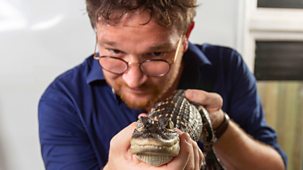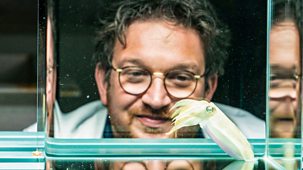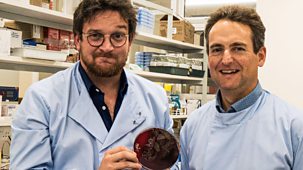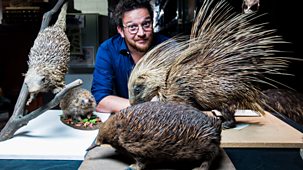
Series 1: 2. Moving
What makes sharks built for speed? How do snakes move without limbs? How do sugar gliders fly without feathers? The answer all lies in their skin. \n\nProfessor Ben Garrod uncovers the secrets of how skin has evolved to enable animals to solve some of the most remarkable challenges on earth. To do this, Ben heads to the specialist flight centre at the Royal Veterinary College to analyse the way a sugar glider uses its skin flaps to stay aloft. He goes diving with sharks at the Blue Planet Aquarium and discovers that, far from being smooth, sharkskin is incredibly rough. It is covered with thousands of tiny teeth that make a shark hydrodynamic. Ben also finds out how the keratinised scales on snakes' bellies are the perfect configuration to allow them to move over virtually any surface they encounter. Amongst many other wonders of how skin has had an impact on nature.
Source: BBC 4
Most recent episodes of Secrets of Skin
Secrets Of Skin
Series 1: 6. Sensing
Professor Ben Garrod explores how some snakes can see using heat, how crocodiles feel through their jaws and how some animals use electricity to navigate their world - and it is ...
03-08-2023
BBC 4
Secrets Of Skin
Series 1: 5. Defence
What is the most toxic animal on earth? How are porcupine quills helping us in medicine? Why is a rhino armour plated, and it is not to protect them from lions? \n\nProfessor Be ...
02-08-2023
BBC 4
Secrets Of Skin
Series 1: 4. Communication
Why are male mandrill faces (big bold primates from West Africa) red and blue? How are birds' feathers so colourful? What do ringtail lemurs do to talk to one another? Their ski ...
01-08-2023
BBC 4
Secrets Of Skin
Series 1: 3. Protection
How does a giraffe stay cool? What are different porcupine quills teaching us about medicine? What makes some people more likely to be bitten by mosquitoes than others? All the ...
31-07-2023
BBC 4
Secrets Of Skin
Series 1: 2. Moving
What makes sharks built for speed? How do snakes move without limbs? How do sugar gliders fly without feathers? The answer all lies in their skin. \n\nProfessor Ben Garrod uncov ...
27-07-2023
BBC 4
Secrets Of Skin
Series 1: 1. Adaptability
Skin is an incredible, multi-function organ that science is still learning so much about. It has adapted to allow animals to conquer virtually every habitat on the planet. \n\nI ...
26-07-2023
BBC 4
Most popular episodes of Secrets of Skin
Secrets Of Skin
Series 1: 4. Communication
Why are male mandrill faces (big bold primates from West Africa) red and blue? How are birds' feathers so colourful? What do ringtail lemurs do to talk to one another? Their ski ...
01-08-2023
BBC 4
Secrets Of Skin
Series 1: 3. Protection
How does a giraffe stay cool? What are different porcupine quills teaching us about medicine? What makes some people more likely to be bitten by mosquitoes than others? All the ...
31-07-2023
BBC 4
Secrets Of Skin
Series 1: 1. Adaptability
Skin is an incredible, multi-function organ that science is still learning so much about. It has adapted to allow animals to conquer virtually every habitat on the planet. \n\nI ...
26-07-2023
BBC 4
Secrets Of Skin
Series 1: 2. Moving
What makes sharks built for speed? How do snakes move without limbs? How do sugar gliders fly without feathers? The answer all lies in their skin. \n\nProfessor Ben Garrod uncov ...
27-07-2023
BBC 4
Secrets Of Skin
Series 1: 5. Defence
What is the most toxic animal on earth? How are porcupine quills helping us in medicine? Why is a rhino armour plated, and it is not to protect them from lions? \n\nProfessor Be ...
02-08-2023
BBC 4
Secrets Of Skin
Series 1: 6. Sensing
Professor Ben Garrod explores how some snakes can see using heat, how crocodiles feel through their jaws and how some animals use electricity to navigate their world - and it is ...
03-08-2023
BBC 4






